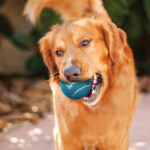
Summer is a wonderful season to enjoy the outdoors with your Labrador Retriever. However, the warm weather also brings an increased risk of fleas and ticks, which can cause severe discomfort and health issues for your furry friend. This comprehensive guide will provide you with essential tips and strategies to protect your Labrador from these pesky parasites during the summer months.
Understanding the Risks
Fleas and ticks are more than just a nuisance; they can carry diseases that pose serious health risks to your Labrador Retriever. Fleas can cause skin irritation, allergic reactions, and even anemia if the infestation is severe. Ticks, on the other hand, are known carriers of Lyme disease, Rocky Mountain spotted fever, and other tick-borne illnesses that can be life-threatening.
Key Tips for Protecting Your Labrador
1. Regular Inspections
One of the most effective ways to protect your Labrador from fleas and ticks is through regular inspections. After each outdoor activity, take a few minutes to thoroughly check your Lab’s fur, paying close attention to areas where fleas and ticks are likely to hide, such as under the collar, around the ears, and between the toes. Early detection can prevent a minor issue from becoming a major infestation.
2. Use Veterinarian-Approved Preventative Products
There are numerous flea and tick prevention products on the market, but not all are created equal. It’s crucial to consult your veterinarian for recommendations on the best and safest products for your Labrador. Frontline is a popular choice, known for its effectiveness in killing fleas, ticks, and their eggs. Avoid using over-the-counter medications without professional advice, as they may not be safe or effective for your pet.
3. Maintain a Clean Living Environment
A clean living environment is essential for preventing flea and tick infestations. Regularly vacuum your home, especially areas where your Labrador spends the most time. Wash their bedding frequently in hot water to kill any hidden parasites. Keeping your yard clean by mowing the grass and removing leaf litter also reduces the habitats available for fleas and ticks.
4. Limit Exposure to High-Risk Areas
Ticks and fleas thrive in tall grasses, wooded areas, and places with dense foliage. While it’s impossible to avoid these environments entirely, especially if your Labrador loves outdoor adventures, try to limit their exposure as much as possible. Stick to well-maintained trails and parks where the vegetation is less likely to harbor these parasites.
5. Consider Landscaping Modifications
You can make your yard less inviting for fleas and ticks by adopting certain landscaping practices. Create a barrier of wood chips or gravel between your lawn and any wooded areas, as ticks are less likely to cross these dry, open spaces. Additionally, consider planting flea-repelling plants such as rosemary, lavender, and lemongrass around your yard.
Common Issues Labrador Retrievers Face with Fleas and Ticks
Skin Irritation and Allergic Reactions
Fleas and ticks can cause significant discomfort for your Labrador Retriever. Bites often lead to itching, redness, and swelling. Some dogs may develop flea allergy dermatitis (FAD), a severe allergic reaction to flea saliva that results in intense itching, hair loss, and secondary infections.
Anemia
In severe cases, a heavy flea infestation can lead to anemia, especially in puppies or older dogs. Fleas feed on your dog’s blood, and a large number of bites can result in a significant loss of blood, leading to weakness, lethargy, and even death if left untreated.
Tick-Borne Diseases
Ticks are notorious for transmitting various diseases, including Lyme disease, ehrlichiosis, and anaplasmosis. Symptoms of these diseases can range from mild to severe and may include fever, joint pain, lameness, and loss of appetite. Early detection and treatment are crucial for a full recovery.
Recommended Preventative Products
Frontline
Frontline is a veterinarian-recommended product known for its efficacy in preventing fleas and ticks. It offers long-lasting protection by killing adult fleas, ticks, and their eggs, breaking the life cycle of these parasites and preventing infestations. Consult your vet to determine the appropriate dosage and application method for your Labrador.
Conclusion
Protecting your Labrador Retriever from fleas and ticks during the summer requires vigilance and proactive measures. By regularly inspecting your dog’s fur, using veterinarian-approved preventative products, maintaining a clean living environment, and limiting exposure to high-risk areas, you can significantly reduce the risk of infestations and keep your furry friend healthy and happy.
FAQ Section
1. How often should I inspect my Labrador for fleas and ticks?
It’s recommended to inspect your Labrador after every outdoor activity, especially during the summer months. Regular checks ensure early detection and prevent infestations from becoming severe.
2. Can I use over-the-counter flea and tick products on my Labrador?
While some over-the-counter products may be effective, it’s best to use veterinarian-approved products like Frontline. Your vet can recommend the safest and most effective options for your pet.
3. What should I do if I find a tick on my Labrador?
If you find a tick on your Labrador, remove it immediately using tweezers or a tick removal tool. Grasp the tick as close to the skin as possible and pull it out slowly and steadily. Clean the area with antiseptic and monitor your dog for any signs of illness.
4. How can I tell if my Labrador has a flea allergy?
Signs of flea allergy dermatitis (FAD) include intense itching, red and inflamed skin, hair loss, and the presence of flea dirt (small black specks) on your dog’s skin. If you suspect FAD, consult your veterinarian for appropriate treatment.
5. Can indoor dogs get fleas and ticks?
Yes, indoor dogs can still get fleas and ticks, especially if they have occasional outdoor access or come into contact with other animals. Regular preventative measures and inspections are essential for all dogs, regardless of their lifestyle.








